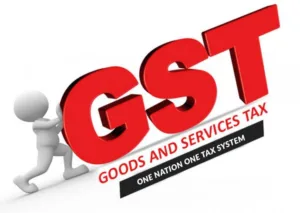Goods and Services Tax- A game changer for India’s economy-Hanief
Mohammad Hanief/ July 8,2023
Goods and Services Tax (GST) is a consumption tax based on the credit- invoice method where only the value addition at each stage is taxed, with seamless flow of credit along the supply chain. It subsumed in its ambit a large number of consumption taxes that previously existed in India, administered separately by the centre and the states, resulting in a greatly rationalized taxation structure.
The umbrella system of GST inter alia integrated the tax administrations of the federal and state governments, making it a single interface for the taxpayers, creating an IT backbone that would match the details of inward & outward supplies at the level of line items, eliminating the cascading effect of taxes thereby making the country’s exports more competitive in the global market and finally removing once and for all the age-old system of check posts for inter-state movement of goods. Besides altering the industrial landscape of the country, GST is also a never-heard-before experiment in fiscal federalism. Cutting across ideologies, politicians, policy makers and tax administrators negotiated, bargained and arrived at decisions – all in the interest of greater common good. The legislations that made up GST were put in public domain for feedback multiple times at each stage, empowering all the stakeholders to deliberate on what kind of future they wanted to help design, in the truest spirit of democracy.
Primarily, GST is a tax levied on the supply of goods and services. In case of an inter-state supply, it is called integrated tax, levied by the federal government, administered jointly by the centre and the States and later apportioned between them. In the case of an intra-state supply, it is levied in two components – the federal tax, levied by the Federal Government and the state tax/union territory tax, levied by the respective administrations.
The idea of a nationwide GST in India was first proposed by the Kelkar Task Force on Indirect taxes in 2000. The objective was to replace the prevailing complex and fragmented tax structure with a unified system that would simplify compliance, reduce tax cascading, and promote economic integration. The empowered committee of state finance ministers prepared a design and roadmap, releasing the First Discussion Paper in 2009. The Constitution Amendment Bill was introduced in 2011 but faced challenges regarding compensation to states and other issues.
After years of deliberation and negotiations between the central and state governments, the Constitution (122nd Amendment) Bill, 2014, was introduced in the Parliament. The bill aimed to amend the constitution to enable the implementation of GST. The Constitution Amendment Bill was passed by the Lok Sabha in May, 2015. The Bill with certain amendments was finally passed in the Rajya Sabha and thereafter by the Lok Sabha in August, 2016. Further, the Bill has been ratified by the required number of States and has since received the assent of the President on 8th September, 2016 and has been enacted as the 101st Constitution Amendment Act, 2016. The GST Council was notified w.e.f. 15th September, 2016.
The GST Council, consisting of the union finance minister and representatives from all States and Union Territories, was established to make decisions on various aspects of GST, including tax rates, exemptions, and administrative procedures. It played a crucial role in shaping the GST framework in India. On 1st July, 2017, GST laws were implemented, replacing a complex web of Central and State taxes. Under the Indian GST, goods and services are categorized into different tax slabs, including 5%, 12%, 18%, and 28%. Some essential commodities are exempted from GST, Gold and job work for diamond attract low rate of taxation. Compensation cess is being levied on demerit goods and ceratin luxury items.
To prepare for the implementation of GST, extensive efforts were made to build the necessary technological infrastructure and train tax officials and businesses. GST Network (GSTN), a not-for-profit company, was created to provide the IT backbone for the GST system, including taxpayer registration, return filing, and tax payments.
Since its implementation, the Indian GST has undergone various amendments and refinements based on feedback from businesses and the evolving economic scenario. While the GST implementation initially posed challenges for businesses in terms of understanding the new compliance requirements and adapting to the changes, it has gradually settled into the Indian tax landscape.
It can be said that the history of GST in India showcases a monumental shift in the country’s tax structure, aiming to create a more unified, efficient, and transparent indirect tax regime for the benefit of businesses and the economy as a whole.

GST and Centre-State Financial Relations
The implementation of GST has brought about a fundamental shift in the financial relations between the Central Government and the State Governments in India. GST is a unified tax system that replaced multiple indirect taxes levied by both the Central and State Governments. Under GST, both the Central and State Governments share the authority to levy and collect taxes on goods and services. This has led to greater harmonization and uniformity in the tax structure across States, promoting economic integration.
The GST system follows a dual structure, comprising Central GST (CGST) and State GST (SGST), levied concurrently by the Central and State governments, respectively. Additionally, an Integrated GST (IGST) is levied on interstate supplies and imports, which is collected by the Central Government but apportioned to the destination state.
In terms of revenue distribution, the GST Council plays a crucial role. It is a joint forum consisting of the Union Finance Minister and representatives from all States and Union Territories. The Council makes decisions on various aspects of GST, including tax rates, exemptions, and revenue sharing between the Central and State Governments. Except for one decision, all decisions of the Council were taken by consensus.
To ensure a smooth transition to the GST regime and address any revenue losses incurred by the States, a compensation mechanism was established. The Central Government was committed to providing compensation to the States for any revenue shortfall during the initial years of GST implementation. This compensation was meant to bridge the gap between the expected revenue growth and the actual revenue collected by the States.
It has fostered greater coordination, reduced tax barriers, and streamlined the tax system, leading to improved efficiency and competitiveness in the Indian economy. The successful implementation of GST relies on a cooperative and consensus-based approach between the Central and State Governments. It has transformed financial relations, ensuring greater coordination and efficiency in the Indian tax system.
Salient Features of GST
Goods and Services Tax (GST) is a comprehensive indirect tax levied on the supply of goods and services in India. Here are some of the salient features of GST:
One Nation, One Tax: GST replaced multiple indirect taxes levied by the Central and State Governments, such as excise duty, service tax, value-added tax (VAT), and others. It brought uniformity in the tax structure across India, eliminating the cascading effect of taxes.
GST operates under a dual structure, comprising the Central GST (CGST) levied by the Central Government and the State GST (SGST) levied by the State Governments. In the case of Inter-state transactions, Integrated GST (IGST) is applicable, which is collected by the Central Government and apportioned to the respective State. Import of goods or services would be treated as inter-state supplies and would be subject to IGST in addition to the applicable customs duties.
GST is a destination-based tax, levied at each stage of the supply chain, from the manufacturer to the consumer. It is applied to the value addition at each stage, allowing for the seamless flow of credits and reducing the tax burden on the end consumer. GST allows for the utilization of input tax credit, wherein businesses can claim credit for the tax paid on inputs used in the production or provision of goods and services. This helps avoid double taxation and reduces the overall tax liability.
GST would apply on all goods and services except Alcohol for human consumption. GST on five specified petroleum products (Crude, Petrol, Diesel, ATF & Natural Gas) would by applicable from a date to be recommended by the GSTC. Tobacco and tobacco products would be subject to GST. In addition, the Centre would have the power to levy Central Excise duty on these products. Exports are zero-rated supplies. Thus, goods or services that are exported would not suffer input taxes or taxes on finished products.

The Indian model of GST is unique in the sense that it is one of few countries in the world that have implemented a dual structure (other examples being Canada and Brazil), thereby ensuring that both the Centre and the States have an equal stake in the case of intra-State supplies of goods or services. Another notable aspect about the Indian GST model is the invoice-matching system that has been implemented. An estimated three billion invoices are expected to be matched on a monthly basis to ensure seamless flow of credit among the taxpayers.
(Note: The views expressed are personal. The author is a regular columnist and can be mailed at [email protected])












